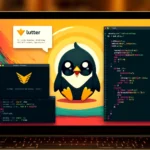Introduction
Welcome to our comprehensive guide on building your first Flutter app! Flutter is an open-source UI toolkit developed by Google that allows you to create beautiful, natively compiled applications for mobile, web, and desktop from a single codebase. This guide will take you through the step-by-step process of setting up your Flutter environment and building your first Flutter app. Whether you’re a complete beginner or have some experience with other frameworks, this guide is designed to help you get started quickly and easily.
Table of Contents
- Prerequisites
- Setting Up Flutter
- Creating a New Flutter Project
- Understanding the Project Structure
- Building the User Interface
- Adding Interactivity
- Running the App
- Conclusion
Prerequisites
Before you begin, ensure you have the following:
- Flutter SDK: Installed on your system.
- IDE: Visual Studio Code or Android Studio with Flutter and Dart plugins installed.
- Device: An emulator or a physical device for testing.
Setting Up Flutter
If you haven’t set up Flutter yet, follow these steps for your specific platform:
- Download the Flutter SDK: Visit the Flutter website and download the SDK for your operating system.
- Extract the Flutter SDK: Extract the downloaded file to your desired location.
- Add Flutter to Your PATH: Add the Flutter
bindirectory to your system’s PATH environment variable. - Install Required Tools: Depending on your operating system, you may need to install additional tools such as Android Studio for Android development and Xcode for iOS development.
Creating a New Flutter Project
- Open Terminal or Command Prompt
- Navigate to Your Development DirectorybashCopy code
cd path/to/your/development/directory - Create a New Flutter ProjectbashCopy code
flutter create my_first_app - Navigate to the Project DirectorybashCopy code
cd my_first_app
Understanding the Project Structure
A typical Flutter project has the following structure:
bashCopy codemy_first_app/
├── android/
├── ios/
├── lib/
│ ├── main.dart
├── test/
├── pubspec.yaml
└── README.md
lib/main.dart: The entry point of your Flutter application.pubspec.yaml: The configuration file for your Flutter project.
Building the User Interface
- Open
lib/main.dart - Replace the Default Code with the FollowingdartCopy code
import 'package:flutter/material.dart'; void main() { runApp(MyApp()); } class MyApp extends StatelessWidget { @override Widget build(BuildContext context) { return MaterialApp( title: 'My First Flutter App', theme: ThemeData( primarySwatch: Colors.blue, ), home: MyHomePage(), ); } } class MyHomePage extends StatefulWidget { @override _MyHomePageState createState() => _MyHomePageState(); } class _MyHomePageState extends State<MyHomePage> { int _counter = 0; void _incrementCounter() { setState(() { _counter++; }); } @override Widget build(BuildContext context) { return Scaffold( appBar: AppBar( title: Text('My First Flutter App'), ), body: Center( child: Column( mainAxisAlignment: MainAxisAlignment.center, children: <Widget>[ Text( 'You have pushed the button this many times:', ), Text( '$_counter', style: Theme.of(context).textTheme.headline4, ), ], ), ), floatingActionButton: FloatingActionButton( onPressed: _incrementCounter, tooltip: 'Increment', child: Icon(Icons.add), ), ); } }
Adding Interactivity
- Increment Counter Functionality: The
_incrementCountermethod increases the_countervariable and updates the UI usingsetState. - FloatingActionButton: This button calls
_incrementCounterwhen pressed.
dartCopy codefloatingActionButton: FloatingActionButton(
onPressed: _incrementCounter,
tooltip: 'Increment',
child: Icon(Icons.add),
),
Running the App
- Open Terminal or Command Prompt
- Ensure Your Emulator is Running or Your Physical Device is Connected
- Run the AppbashCopy code
flutter run
Conclusion
Congratulations! You’ve built and run your first Flutter app. This guide introduced you to the basics of Flutter development, including setting up your environment, creating a new project, building a user interface, and adding interactivity. For more advanced topics, continue exploring Flutter’s extensive documentation and keep experimenting with your app.

I’ve been browsing online more than 3 hours today, yet I never found any interesting article like yours. It is pretty worth enough for me. Personally, if all site owners and bloggers made good content as you did, the net will be much more useful than ever before.
I am really enjoying the theme/design of your web site. Do you ever run into any internet browser compatibility issues? A handful of my blog readers have complained about my website not operating correctly in Explorer but looks great in Opera. Do you have any ideas to help fix this issue?
you’re really a good webmaster. The web site loading speed is incredible. It seems that you’re doing any unique trick. Moreover, The contents are masterpiece. you’ve done a magnificent job on this topic!
Hey there! I’ve been reading your blog for a long time now and finally got the bravery to go ahead and give you a shout out from Austin Texas! Just wanted to tell you keep up the good job!